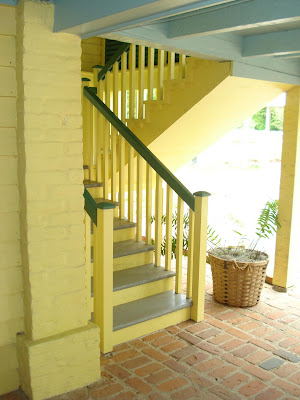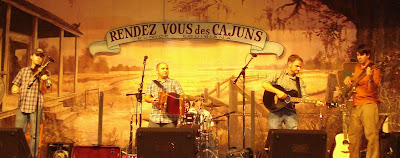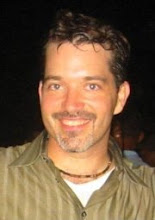I missed these two stories on Yoani, the
Blogger Academy, and
Teaching Twitter when they first came out on
NPR and at
Global Post in the last few weeks. But you can read the
NPR story below and stream it by clicking
here [4 min 57 sec]. The Teaching Twitter article is also pasted below, or you can read it at
the Global Post. (Also see Yoani's latest post about Twitter, that savage beast,
here).
(By the way, watch
Nick Miroff of the Global Post, he has written a stream of
solid reports on Cuba over the past few months.
Here's a link to one from last October.)
 "Spreading Digital Revolution
"Spreading Digital RevolutionIn A Cuban Living Room"
by Nick Miroff for NPR, April 9, 2010, Morning Edition
Twice a week, Yoani Sanchez transforms the living room of her small Havana high-rise apartment into what she calls the Blogger Academy. About 30 students cram inside to learn how to use WordPress, Wikipedia and the other tools of a digital revolution that Cuba's government views warily.
The small group of young Cuban bloggers has drawn international attention to their campaign for greater freedom of expression and Internet access. The government treats them as a security threat, backed by anti-Castro forces abroad.
On a recent afternoon, Sanchez is teaching her students about Twitter. Few Cubans have an Internet connection, so Sanchez is demonstrating how to send tweets from a cell phone.
There are a handful of laptops in the room, along with photocopies of articles with titles like, "Can Journalism Be Participatory?"
Sanchez, 34, has long black hair and the weary intensity of someone who has been living on the edge for a long time.
"Unfortunately, in Cuba, the act of wanting to find out what the official media is hiding is viewed as an attack on the integrity of the state," she says. "But that's not our intention. This is an educational project, not a political one."
Cuban blogger Yoani Sanchez teaches students in her Blogger Academy
how to use Twitter and other digital media tools.
(Photo by Nick Miroff - Gotta love those GY earrings!)
Blogging Without An Internet Connection
Sanchez's blog, Generation Y, is political, but not with the kind of overheated rhetoric that has characterized the Cuba debate for so long. It's earned her several international awards, and though the blog is blocked on the island by the Cuban government, it's accessible through third-party Web sites.
Because she isn't allowed to have an Internet connection, Sanchez says, she writes her blog from home, then goes to tourist hotels and e-mails several postings at a time to friends abroad who run the blog for her. They send back reader comments, which often number in the thousands.
Among Cubans abroad, Sanchez has become the island's most famous symbol of opposition to the Castro government. But her name isn't mentioned in state-run newspapers or on TV here, and she's not widely known.
When her activism has moved from the computer screen to the streets, the response from authorities has been swift. The Blogger Academy has been left alone so far, though some students say they have been harassed by police and had equipment confiscated.
"We are Cubans ... We are living in the revolution — or maybe in the post-revolution — and we are good persons," says Orlando Luis Pardo, a 38-year-old blogger who is part of the academy.
"We don't [intend] to create chaos, social chaos. On the contrary, we [intend] ... that people in Cuba regain somehow their hope in Cuba, because a lot of young people that I know will say, 'When you get some money, find your way out of the country.' "
Countering Critics
Cuba's bloggers have attracted the attention of President Obama, and he gave Sanchez an interview by e-mail last fall. It's that degree of American enthusiasm for Sanchez that gives the Cuban government cause to view her and her group as a tool of U.S. foreign policy.
In another apartment building on the opposite side of Havana's Revolution Square, journalist Rosa Miriam Elizalde strikes back at Cuba's critics from a Macintosh laptop in her bedroom. She's the editor of Cubadebate, the pro-government Web site best known for its most famous contributor, retired President Fidel Castro. He writes a Web feature called "Fidel's Reflections."
Elizalde follows Sanchez's tweets and counters them with her own.
"We're not talking about some blogger in Sweden," Elizalde says. "We're talking about a blogger in Cuba, which the United States has been waging economic and political warfare against for the past 50 years. And this is just the latest form of that warfare."
Who's The Underdog?
Just as Sanchez sees her small group standing up to the power of the Cuban state, Elizalde sees Cuba as the underdog, besieged by a hostile media and the giant to the north. She says she doesn't have a problem with the Blogger Academy. But to her, Sanchez's overnight fame and the international support for her blog seem like a coordinated campaign to attack Cuba.
"I think she's a symbol that's been constructed for a specific political purpose, as part of an aggressive U.S. foreign policy," Elizalde says. "She obviously gets a lot of technical support if she's running a site that's being translated into 18 languages."
Sanchez says she will continue using the money she has made from her writing and her awards to help other Cubans launch their own blogs.
She says the waiting list for her next Blogger Academy course is nearly full.
Teaching Twitter in Havana
By Nick Miroff- Special to Globalpost, April 22, 2010
Graphic stolen from Yoani's latest post at Generacion Y.
HAVANA, Cuba — As an educational institution, Cuba’s Blogger Academy suffers from a few notable deficiencies. Its six-month course doesn’t grant an accredited degree, and its single, cramped classroom — the living room of founder Yoani Sanchez — isn’t even hooked up to the internet.
Then there’s the possibility that the next knock on the door might be the police. They haven’t shut down the Blogger Academy yet, but on this web-starved island — the least-connected country in the hemisphere — this classroom is a place where the digital revolution really feels like one.
At least the 30-odd students squeezed onto benches and chairs in Sanchez’s 14th-floor Havana apartment see it that way. They’re taking a risk to come here twice a week to learn how to use Twitter, or write code in Wordpress for their own blogs. That’s not because those software programs are illegal in Cuba, but because Sanchez, 34, is considered dangerous company.
Sanchez remains largely unknown on the island, where her award-winning blog, Generation Y, is blocked. But she has a huge following among Cubans living abroad, and she has used her literary talents and the power of the internet to become a potent symbol of opposition to a one-party socialist system run by men in their 70s and 80s. With the Blogger Academy, where the instructors are volunteers and tuition is free, Sanchez is drafting others to the digital cause.
“Today we're going to talk about Twitter,” Sanchez began on a recent afternoon, quieting the room. The students ranged in age from early 20s to mid-50s. One’s man late father had been a leader of the Cuban Revolution. Given the Castro government’s record of infiltrating opposition groups, it was also likely a few of the students were there to take notes on their classmates, not their coursework.
No one seemed too worried about that, though, and the atmosphere was friendly, almost festive. Sanchez used a projector to cast an image of her laptop screen onto the wall, displaying web pages she’d saved from the last time she was able to use the internet. Like most Cubans, she isn’t allowed to have an internet connection at home but can pay to go online at hotels and cyber cafes. “Who can tell me the difference between tags and categories?” she asked the class.
There were other classes that day on journalism ethics, photography, and Wikipedia. A nearby table was stacked with photocopied handouts of articles with titles like “Can Journalism be Participatory?” and a Twitter manifesto called “The revolution in 140 characters.” Students huddled to share the room’s few laptop computers.
At most journalism schools, it would be ordinary subject matter. But on an island where the media is almost entirely state-controlled and less than 1 percent of the population has an internet connection, it seemed like the first tremors of a paradigm shift.
Cuban authorities, meanwhile, see it as little more than a new phase of an old fight. They view Sanchez’s rapid rise to international fame as part of the broader U.S.-funded campaign to foment anti-Castro activity on the island. Sanchez insists she funds the academy and supports other bloggers with the money she’s earned by publishing articles and a book abroad.
“We’re not trying to challenge or subvert the government,” Sanchez said in an interview. “This isn’t a political party. There’s no boss here, and no director. No one is telling us what to write, or what type of criticisms we can make. We’re just trying to create a virtual world that reflects the variety of views that Cubans really have — but are now suffocated and hidden by government controls.”
Rosa Miriam Elizalde, the editor of the pro-government website
Cubadebate, said she views Sanchez as a figure who has been hyped up for a specific political purpose — to attack Cuba. Elizalde said there was nothing wrong with the material taught at the Blogger Academy, but she said Sanchez’s goals were hardly apolitical.
“You can’t criticize learning,” Elizalde said. “But you can criticize the intention behind her efforts, which are taking place in a framework of a U.S. policy of subversion and aggression.”
Elizalde also questions the international support Sanchez receives to run her blog, which is translated into 18 languages. “We’re not talking about some blogger in Sweden,” Elizalde said. “We’re talking about a blogger in Cuba, which the United States has been waging economic and political warfare against for the past 50 years. And this is just the latest form of that warfare.”
Several of the academy’s students say they’ve faced more than criticism in recent months, receiving threats and other forms of harassment from the government. A few said their computers and cell phones had been confiscated by state police.
“There are people who think I’m doing something wrong by coming here, but I don’t think so,” said Regina Coyula, 53, a housewife and former Cuban state security agent who now writes a blog,
Mala Letra (Bad Handwriting), launched with Sanchez’s help.
“I think I’m giving a voice to a lot of people who think like I do, whose views aren’t reflected in the official media,” said Coyula. “We’re people who want change, and we want the current government to be an instrument of change.”
Sanchez said the academy's graduates are developing the skills to shape Cuba’s future media organizations. Blogger Orlando Luis Pardo described their one-room school with a quote from famous Cuban novelist Jose Lezama Lima, likening it to “building a cathedral in the air.”
“Somehow this is the image that I have,” Pardo said. “Something very big and very beautiful that we are trying to build, and very fragile also, that could crumble to the ground at any time.”
“We hope not,” he said, “but it’s something very fragile.”























































